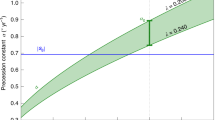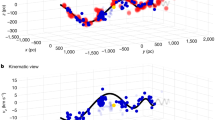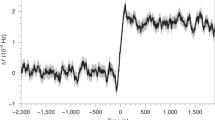Abstract
Images1–3 of the comet Halley nucleus by the Vega and Giotto spacecraft and a compilation4 of recurring events show a 'rotation' period of roughly 2.2 days. In contrast, molecular emission intensities5 (C2 and CN) in the inner coma exhibit 7.4-day periodic variations. In this report the comet Halley nucleus is modelled dynamically as a rigid homogeneous ellipsoid with three unequal principal axes in torque-free rotation about its centre of mass. Two qualitatively-distinct, free-precessional modes are found, each exhibiting both 2.2-day and 7.4-day periodicities. As viewed from the nucleus, the two modes are distinguished by the closed path (called a polhode) that the end of the angular velocity vector traces with a period of 7.4 days (see Fig. 1). The long-axis mode has a polhode that encloses only the long principal axis of the nucleus. It reduces to a motion proposed by Sekanina6,7 when the minor axes are equal. However, because the polhode encloses the long axis in a long-axis mode, the resulting motion with a 7.4-day period around that axis conflicts8 with the Vega and Giotto images of the nucleus. The short-axis mode occurs when the minor axes are unequal and the polhode encloses only the short principal axis of the nucleus. The resulting motion is around the short axis and does not conflict with the spacecraft images.
This is a preview of subscription content, access via your institution
Access options
Subscribe to this journal
Receive 51 print issues and online access
$199.00 per year
only $3.90 per issue
Buy this article
- Purchase on Springer Link
- Instant access to full article PDF
Prices may be subject to local taxes which are calculated during checkout
Similar content being viewed by others
References
Sagdeev, R. Z. et al. Nature 321, 262–266 (1986).
Sekanina, Z. & Larson, S. M. Nature 321, 357–361 (1986).
Vaisberg, O. L. et al. Nature 321, 274–276 (1986).
Sekanina, Z. Adv. Space Res. 5, 307–316 (1986).
Millis, R. L. & Schleicher, D. G. Nature 324, 646–649 (1986).
Sekanina, Z. Nature 325, 326–328 (1987).
Sekanina, Z. IAU Circ. No. 4273 (1986).
Smith, B. A., Larson, S. M., Szegö, K. & Sagdeev, R. Z. Nature (in the press).
Landau, L. D. & Lifshitz, E. M. Mechanics (Pergamon, Oxford, 1960).
Julian, W. H. & Zund, J. D. Stud. appl. Math. 75, 171–177 (1986).
Author information
Authors and Affiliations
Rights and permissions
About this article
Cite this article
Julian, W. Free precession of the comet Halley nucleus. Nature 326, 57–58 (1987). https://doi.org/10.1038/326057a0
Received:
Accepted:
Published:
Issue Date:
DOI: https://doi.org/10.1038/326057a0
This article is cited by
-
On the rotation of comet Borrelly’s nucleus
Celestial Mechanics and Dynamical Astronomy (2008)
-
Comets
The Astronomy and Astrophysics Review (1993)
-
Indication for precession of comet Halley's nucleus from dust tail analysis
Earth, Moon, and Planets (1990)
-
On the rotation axis of comet Halley
Nature (1988)
Comments
By submitting a comment you agree to abide by our Terms and Community Guidelines. If you find something abusive or that does not comply with our terms or guidelines please flag it as inappropriate.



